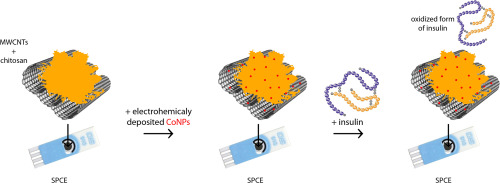当前位置:
X-MOL 学术
›
J. Electroanal. Chem.
›
论文详情
Our official English website, www.x-mol.net, welcomes your feedback! (Note: you will need to create a separate account there.)
Electrochemical determination of insulin at CuNPs/chitosan-MWCNTs and CoNPs/chitosan-MWCNTs modified screen printed carbon electrodes
Journal of Electroanalytical Chemistry ( IF 4.5 ) Pub Date : 2020-03-01 , DOI: 10.1016/j.jelechem.2020.113881 Ivana Šišoláková , Jana Hovancová , Renáta Oriňaková , Andrej Oriňak , Libuše Trnková , Iveta Třísková , Zdeněk Farka , Matěj Pastucha , Jozef Radoňák
Journal of Electroanalytical Chemistry ( IF 4.5 ) Pub Date : 2020-03-01 , DOI: 10.1016/j.jelechem.2020.113881 Ivana Šišoláková , Jana Hovancová , Renáta Oriňaková , Andrej Oriňak , Libuše Trnková , Iveta Třísková , Zdeněk Farka , Matěj Pastucha , Jozef Radoňák

|
Abstract Transition metal nanoparticles can be considered as promising low cost materials for insulin oxidation catalysis. Combination of transition metal nanoparticles with multi walled carbon nanotubes (MWCNTs), which enlarges the active surface area of the electrode, can improve the analytical characteristics of electrodes. Two types of screen printed carbon electrodes (SPCEs) modified by the combination of copper (CuNPs) or cobalt (CoNPs) nanoparticles with chitosan and MWCNTs were prepared. In the effort to find the most suitable modification for electrochemical insulin determination, stability, analytical characteristics and selectivity of both electrode types were compared. The results proved better stability and analytical characteristics with no significant influence of interferences on insulin determination at CoNPs/chitosan-MWCNTs/SPCE. These electrodes provided low limit of detection (25 nM), high sensitivity (0.031 mA μM−1) and wide linear range (0.05 μM to 5 μM) for insulin determination. The stability of the CoNPs/chitosan-MWCNTs/SPCE was very high, with only 1.7% decrease of maximal current value after 50 measurements. Therefore, CoNPs/chitosan-MWCNTs/SPCE can be considered as the suitable modification for new electrochemical sensor for insulin determination, with better analytical characteristics in comparison with SPCE modification using MWCNTs, chitosan and CuNPs described in this study.
中文翻译:

CuNPs/壳聚糖-MWCNTs和CoNPs/壳聚糖-MWCNTs修饰丝网印刷碳电极上胰岛素的电化学测定
摘要 过渡金属纳米颗粒可被认为是一种有前景的低成本胰岛素氧化催化材料。过渡金属纳米粒子与多壁碳纳米管 (MWCNTs) 的结合,扩大了电极的活性表面积,可以改善电极的分析特性。制备了两种由铜 (CuNPs) 或钴 (CoNPs) 纳米粒子与壳聚糖和 MWCNTs 组合改性的丝网印刷碳电极 (SPCE)。为了找到最适合电化学胰岛素测定的改进,对两种电极类型的稳定性、分析特性和选择性进行了比较。结果证明,在 CoNPs/壳聚糖-MWCNTs/SPCE 上,干扰对胰岛素测定没有显着影响,具有更好的稳定性和分析特性。这些电极为胰岛素测定提供了低检测限 (25 nM)、高灵敏度 (0.031 mA μM-1) 和宽线性范围 (0.05 μM 至 5 μM)。CoNPs/壳聚糖-MWCNTs/SPCE 的稳定性非常高,50 次测量后最大电流值仅降低 1.7%。因此,CoNPs/壳聚糖-MWCNTs/SPCE 可以被认为是适合用于胰岛素测定的新型电化学传感器的改性,与本研究中描述的使用 MWCNT、壳聚糖和 CuNP 的 SPCE 改性相比具有更好的分析特性。50 次测量后最大电流值降低 7%。因此,CoNPs/壳聚糖-MWCNTs/SPCE 可以被认为是适合用于胰岛素测定的新型电化学传感器的改性,与本研究中描述的使用 MWCNT、壳聚糖和 CuNP 的 SPCE 改性相比具有更好的分析特性。50 次测量后最大电流值降低 7%。因此,CoNPs/壳聚糖-MWCNTs/SPCE 可以被认为是适合用于胰岛素测定的新型电化学传感器的改性,与本研究中描述的使用 MWCNT、壳聚糖和 CuNP 的 SPCE 改性相比具有更好的分析特性。
更新日期:2020-03-01
中文翻译:

CuNPs/壳聚糖-MWCNTs和CoNPs/壳聚糖-MWCNTs修饰丝网印刷碳电极上胰岛素的电化学测定
摘要 过渡金属纳米颗粒可被认为是一种有前景的低成本胰岛素氧化催化材料。过渡金属纳米粒子与多壁碳纳米管 (MWCNTs) 的结合,扩大了电极的活性表面积,可以改善电极的分析特性。制备了两种由铜 (CuNPs) 或钴 (CoNPs) 纳米粒子与壳聚糖和 MWCNTs 组合改性的丝网印刷碳电极 (SPCE)。为了找到最适合电化学胰岛素测定的改进,对两种电极类型的稳定性、分析特性和选择性进行了比较。结果证明,在 CoNPs/壳聚糖-MWCNTs/SPCE 上,干扰对胰岛素测定没有显着影响,具有更好的稳定性和分析特性。这些电极为胰岛素测定提供了低检测限 (25 nM)、高灵敏度 (0.031 mA μM-1) 和宽线性范围 (0.05 μM 至 5 μM)。CoNPs/壳聚糖-MWCNTs/SPCE 的稳定性非常高,50 次测量后最大电流值仅降低 1.7%。因此,CoNPs/壳聚糖-MWCNTs/SPCE 可以被认为是适合用于胰岛素测定的新型电化学传感器的改性,与本研究中描述的使用 MWCNT、壳聚糖和 CuNP 的 SPCE 改性相比具有更好的分析特性。50 次测量后最大电流值降低 7%。因此,CoNPs/壳聚糖-MWCNTs/SPCE 可以被认为是适合用于胰岛素测定的新型电化学传感器的改性,与本研究中描述的使用 MWCNT、壳聚糖和 CuNP 的 SPCE 改性相比具有更好的分析特性。50 次测量后最大电流值降低 7%。因此,CoNPs/壳聚糖-MWCNTs/SPCE 可以被认为是适合用于胰岛素测定的新型电化学传感器的改性,与本研究中描述的使用 MWCNT、壳聚糖和 CuNP 的 SPCE 改性相比具有更好的分析特性。



























 京公网安备 11010802027423号
京公网安备 11010802027423号